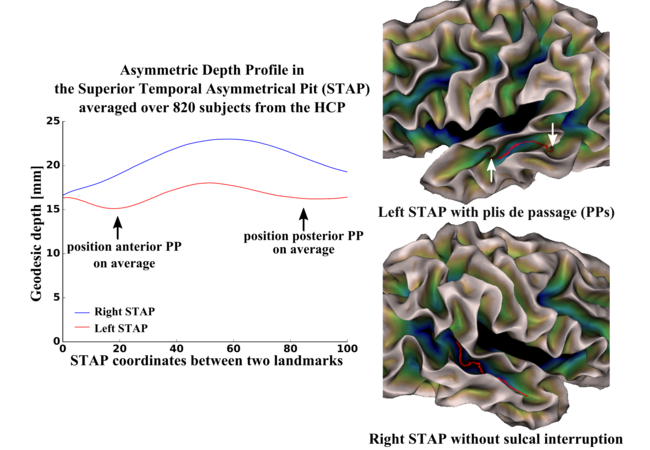The chaotic morphology of the left STS

© NeuroSpin/CEA. The asymmetry of the superior temporal sulcus (STS) has been identified as a species-specific feature of the human brain. The so-called superior temporal asymmetrical pit (STAP) area is observed from the last trimester of gestation onwards and is far less pronounced in the chimpanzee brain.
This asymmetry is associated with more frequent sulcal interruptions, named plis de passage (PPs), leading to the irregular morphology of the left sulcus. Y Le Guen (PhD 2015-2018) and colleagues (NeuroSpin/Brainomics) worked to characterize the variability, asymmetry, and heritability of these interruptions in the STS in comparison with the other main sulci. We developed an automated method to extract PPs across the cortex based on a highly reproducible grid of sulcal pits across individuals, which they applied to a subset of Human Connectome Project (HCP) subjects (N = 820). Only a few PPs across the cortex are genetically constrained, namely in the collateral, postcentral and superior temporal sulci and the calcarine fissure. Moreover, some PPs occur more often in one hemisphere than the other, namely in the precentral, postcentral, intraparietal sulci, as well as in both inferior and superior temporal sulci. Most importantly, we found that only the interruptions within the STAP region are both asymmetric and genetically constrained. Because this morphological pattern is located in an area of the left hemisphere related to speech, these results suggest structural constraints on the architecture of the linguistic network.
Le Guen, Y., Leroy, F., Auzias, G., Riviere, D., Grigis, A., Mangin, J.-F., Coulon, C., Dehaene-Lambertz, G. and Frouin, V. (2018). The chaotic morphology of the left superior temporal sulcus is genetically constrained. NeuroImage, 174, 297–307. http://doi.org/10.1016/j.neuroimage.2018.03.046